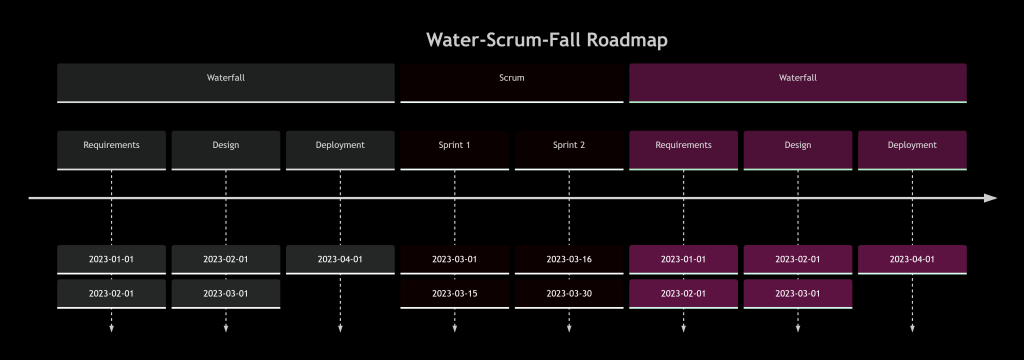Yes, it’s possible—and sometimes beneficial—to blend Waterfall (structured phases) with Scrum (iterative agility). This hybrid model is often called “Wagile” or “Water-Scrum-Fall.” Here’s how it works, when to use it, and key pitfalls to avoid.
1. How to Combine Waterfall and Scrum
A. High-Level Waterfall + Sprint-Level Scrum
| Phase | Waterfall Process | Scrum Integration |
|---|---|---|
| Requirements | Detailed upfront planning | Refine backlog in sprint grooming |
| Design | Architecture signed off | Sprint tasks allow flexibility |
| Development | Fixed milestones | 2-4 week sprints with daily standups |
| Testing | Separate phase | Continuous testing in each sprint |
| Deployment | Big-bang release | Optional: Mini-releases per sprint |
Example:
- A construction firm uses Waterfall for permits/blueprints (legal requirements) but Scrum for actual building phases (iterative adjustments).
B. Waterfall for Governance, Scrum for Execution
- Waterfall:
- Used for contracts, compliance, and high-level roadmap.
- Scrum:
- Used for development sprints (flexibility in how work gets done).
Example:
- A healthcare app uses Waterfall for FDA approval documentation but Scrum for feature development.
2. When Hybrid Works Best
✅ Regulated Industries (Healthcare, Finance) – Where documentation is mandatory.
✅ Fixed-Price Contracts – Clients want cost certainty but teams need agility.
✅ Hardware/Software Mix – Waterfall for hardware, Scrum for firmware.
Common Use Cases:
- Government projects
- Medical device development
- Construction tech
3. Potential Pitfalls
❌ Too Much Bureaucracy – Waterfall phases slow down Scrum’s agility.
❌ Misaligned Teams – Designers work in Waterfall, devs in Scrum → handoff delays.
❌ Scope Creep – Stakeholders treat Scrum iterations as “free changes” post-Waterfall signoff.
How to Avoid:
- Clearly define what’s fixed (Waterfall) vs. what’s flexible (Scrum).
- Use gated reviews (e.g., “Design signoff = Waterfall, but coding = Scrum”).
4. Step-by-Step Hybrid Implementation
Phase 1: Waterfall (Planning)
- Requirements: Document all specs (PRD, SOW).
- Design: Approve architecture/UI mockups.
- Signoff: Freeze scope for first release.
Phase 2: Scrum (Execution)
- Sprint 0: Setup (tools, backlog refinement).
- Sprints 1-N: Develop features iteratively.
- Continuous Testing: QA in each sprint.
Phase 3: Waterfall (Delivery)
- UAT + Compliance: Formal testing.
- Big-Bang Launch: Deploy finalized product.
5. Tools to Manage Hybrid Workflows
- Jira + Confluence: Track sprints (Scrum) alongside Waterfall docs.
- Gantt Charts: Show high-level milestones (Waterfall) with sprint timelines.
- Hybrid Roadmaps:

6. Real-World Example
Project: Banking App
- Waterfall:
- Contract with regulators required upfront specs.
- Security/audit trails followed strict phases.
- Scrum:
- Features like UI/transaction flows built iteratively.
- Biweekly demos for stakeholder feedback.
Outcome:
- Met compliance deadlines (Waterfall).
- Delivered user-friendly features (Scrum).




